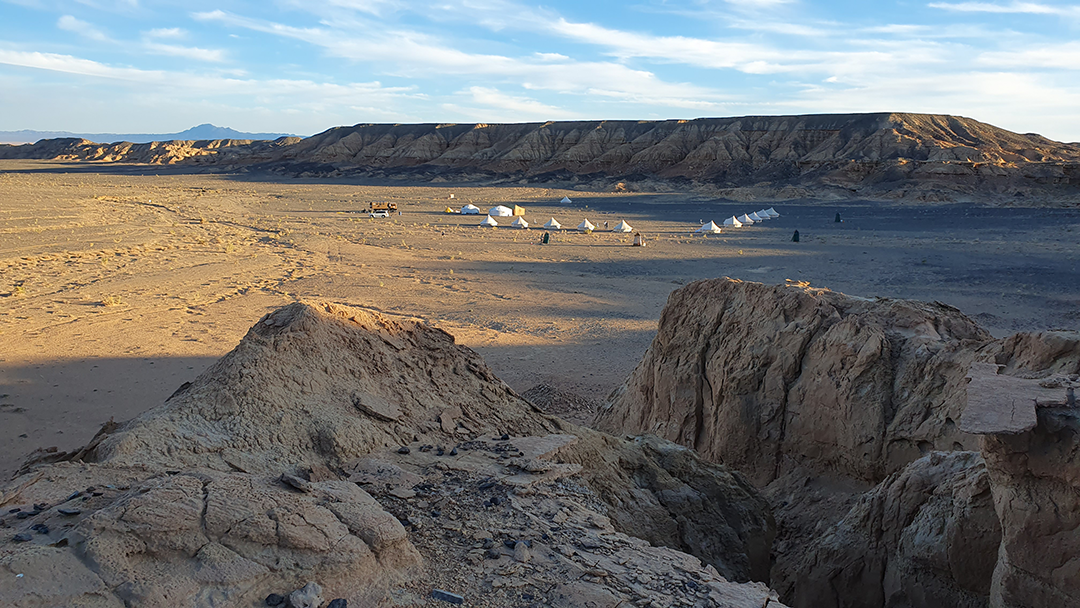Three weeks in the Gobi Desert excavating dinosaur bones and visiting the ‘Dragon’s Tomb’ – sound like fun? You bet, says UNE dinosaur expert Dr Phil Bell and his PhD student Nathan Enriquez, who recently returned from an expedition to the “dinosaur mecca” in remote southern Mongolia.
The pair joined palaeontologists from Mongolia, Canada and America on the barren flanks of Nemegt Mountain to dig for what remained of a giant sauropod that roamed the landscape 70 million years ago. Nemegtosaurus, a long-necked, herbivorous dinosaur more than 10 metres long, is one of many species found in this renowned deposit.
Image: Excavating the leg of a dinosaur
“It is one of the best places in the world to study dinosaur ecology because everything is there – from the giant sauropods to the smallest mammals and lizards and everything in between,” said Phil, who’s primary research interest is dinosaur skin.
The team spent just over a week jackhammering a 6-metre cliff-face, followed by several days of hand-tool excavations to collect the remains of the Nemegtosaurus first discovered by Polish palaeontologists in 1970.
It was a good place for dinosaurs to live and an even better place for them to die.
“It was a good place for dinosaurs to live and an even better place for them to die,” said Phil. “Back in the Cretaceous, it was covered in seasonal wetlands and animals congregated during the summer monsoon. But the dry winters were very hard and many of the animals would then die. Spring floods buried their skeletons, but now the rock has been exposed again, for us to come and find their bones.”
Image: Red cliffs of Nemegt
Unfortunately, all the hard-working team could recover were isolated bones from the animal’s lower leg, including an ankle bone, shin bone, calf bone and toe bone. “It wasn’t the complete skeleton we were hoping for, but this is the only known skeleton of this particular species and previously we only had its skull, so every fossil helps us to fill in the missing gaps,” Phil said.
However, there were some other “really exciting finds” – the lower jaw of a bone-headed pachycephalosaur and “thousands upon thousands” of dinosaur footprints so beautifully preserved in the rock that they contained the impressions of skin, scales and claws.
The more information we can gather about each species, including the nature of their skin, the better picture we can build of what they looked like and, in the best cases, how they might have behaved and interacted with each other and their environment.
Image: Footprint of a duck-billed dinosaur
“Deep footprints with this level of detail are really important for understanding how the soft tissues looked on these dinosaurs,” Phil said. “The more information we can gather about each species, including the nature of their skin, the better picture we can build of what they looked like and, in the best cases, how they might have behaved and interacted with each other and their environment.”
For third-year PhD student Nathan, the opportunity to visit the famous ‘Dragon’s Tomb’ – a locality about the size of a tennis court that contains a herd of beautifully preserved hadrosaurs named Saurolophus – was a career highlight. He, too, is studying skin – its morphology, how it grows and how it is preserved.
Image: Saurolophus skin at The Dragon's Tomb
“Skin preservation is traditionally patchy but here there are blocks of skin lying around everywhere, which was amazing to see in the field,” he said. “It was the trip of a lifetime. Very few people get to visit this remote part of Mongolia and it’s something I will remember for the rest of my life.”
Conditions during the dig were varied – from hot days in the low-30s to freezing temperatures – and Phil is now nursing an injured shoulder courtesy of all the jackhammering and shovelling, but he revelled in his fourth visit to the Gobi. “With every new discovery, we learn something new,” he said.


